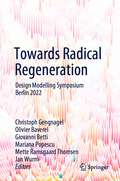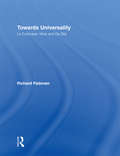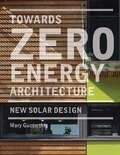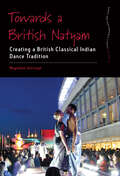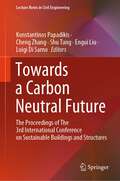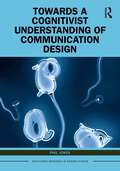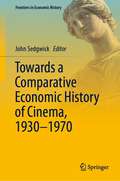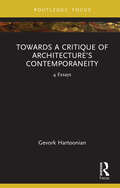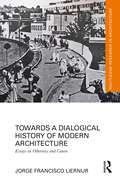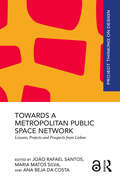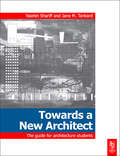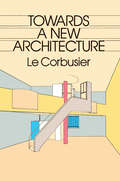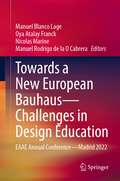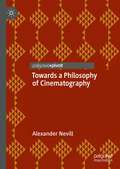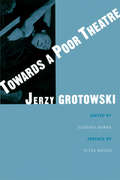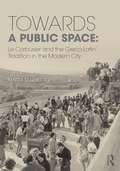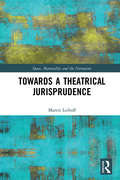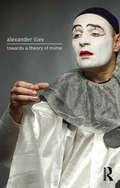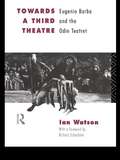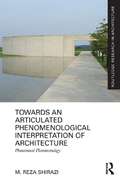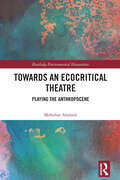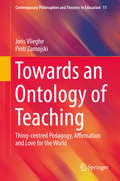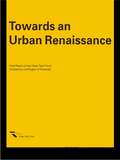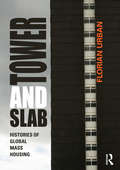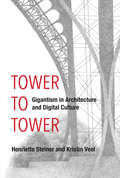- Table View
- List View
Towards Radical Regeneration: Design Modelling Symposium Berlin 2022
by Christoph Gengnagel Mette Ramsgaard Thomsen Olivier Baverel Giovanni Betti Mariana Popescu Jan WurmThis book reflects and expands on the current trends in the Architecture Engineering and Construction (AEC) industries to respond to the unfolding climate and biodiversity crisis. Shifting away from the traditional focus, narrowly centered on efficiency, the book presents a variety of approaches to move the AEC community from an approach that presents new challenges in all areas of the industry, from a linear, extractive paradigm to circular and regenerative one. The book presents contributions including research papers and case studies, providing a comprehensive overview of the field as well as perspectives from related disciplines, such as computer science, biology and material science. The chapter authors were invited speakers at the 8th Design Modelling Symposium “Towards Radical Regeneration”, which took place at the University of the Arts in Berlin in September 2022.
Towards Universality: Le Corbusier, Mies and De Stijl
by Richard PadovanThere is no shortage of books about Le Corbusier, or Mies van der Rohe, or De Stijl. However, this book considers them in relation to each other, observing how a study of one can illuminate the works of the others. Going beyond a superficial look at the end-products of these architects, this book examines the philosophical foundations of their work, taking as its central theme the aim of universality, as opposed to the individual and the particular. Each of these three aimed at universality, but for each this concept took on a different form. The universality of De Stijl and artists like Van Doesburg and Mondrian resembled that of the universe itself: it was boundless, going beyond the limits of the canvas and seeking to abolish the wall as the boundary between interior and exterior space. In contrast, each of Le Corbusier’s creations was a self-contained universe within a clear frame, while Mies fluctuated between these two perspectives.
Towards Zero-energy Architecture: New Solar Design
by Mary GuzowskiThis book explores the theories, practices and principles of new approaches to solar architecture that foster both design excellence and low-energy use. In response to the challenges of global warming and climate change, design and technology enable architects to achieve greater performance standards while at the same time developing an environmental aesthetic. The book showcases ten award-winning buildings to illustrate the aesthetic and technological design integration of solar response in contemporary zero-energy and low-energy architecture. For each project there is a detailed examination of the local climate, the design and construction, and the technology used to reduce energy use. Towards Zero-energy Architecture is a much-needed call for the design professions to redefine architecture to help solve ecological problems.
Towards a British Natyam: Creating a British Classical Indian Dance Tradition (Dance and Performance Studies)
by Magdalen GorringeThe story of the emerging professionalization of classical Indian dance forms in Britain is wrought with contradictions. Though becoming increasingly popular within mainstream culture, the forms lack the clear routes to vocational training so essential for creating a dance career in the traditional sense. Towards a British Natyam uses this lens to analyze the cultural, social, and political frameworks that make a profession possible within the arts. Innovatively drawing on the work of decolonial theorists and the sociologist Pierre Bourdieu, Gorringe illuminates the transformative potential of a classical Indian dance profession to decenter white supremacist modes of knowledge formation and recenter pluriversality.
Towards a Carbon Neutral Future: The Proceedings of The 3rd International Conference on Sustainable Buildings and Structures (Lecture Notes in Civil Engineering #393)
by Luigi Di Sarno Konstantinos Papadikis Cheng Zhang Shu Tang Engui LiuThis book collects the contributions presented at the 3rd International Conference on Sustainable Buildings and Structures ICSBS2023 (Suzhou, China, 17-20 Aug 2023). This conference represents a effort of Design School of Xi'an Jiaotong-Liverpool University, together with international and local co-organizing partners from academia, industry, and professional societies. The collection aims at sharing the state-of-the-art sustainable approaches for future carbon neutrality in the built environment. This work covers a wide range of topics, including sustainable materials and infrastructures, green building design and engineering, smart construction engineering and management, sustainable urbanism and architecture, circular economy, and innovation in education for sustainable development. The contributions were selected through a rigorous peer-review process internationally. They presented the state-of-the-art ideas and approaches in engineering practices and education towards achieving acarbon-neutral tomorrow in the built environment. The collection will be of interest to academics, professionals, industry representatives, and local government officials involved in civil engineering, architecture, urban planning, structural engineering, construction management, and other related fields. The readers will be inspired by novel techniques and ideas of carbon-neutral sustainable development for the built environment.
Towards a Cognitivist Understanding of Communication Design (Routledge Research in Design Studies)
by Phil JonesThis book demonstrates the relevance and importance of cognitive linguistics when applied to the analysis and practice of graphic design/communication design. Phil Jones brings together a diverse range of theory and organizes it in accordance with different stages in the design process. Using examples from contemporary communication design, as well as more familiar selections from the graphic design canon as case studies, this book provides an account of how meanings are made by users, and suggests new strategies for design practice. It seeks convergences between the ways that graphic/communication designers think and talk about their practice and the theories emerging from cognitive science. This book will be of interest to scholars working in design, graphic design, the philosophy of art and aesthetics, communication studies, and media and film studies.
Towards a Comparative Economic History of Cinema, 1930–1970 (Frontiers in Economic History)
by John SedgwickThis book examines the economic circumstances in which films were produced, distributed, exhibited, and consumed during the spoken era of film production until 1970. The periodisation covers the years between the onset of sound and the demise of the phased distribution of films. Films are generally appreciated for their aesthetic qualities. But they are also commodities. This work of economic history presents a new approach, considering consumption behaviour as significant as supply-side decision-making. Audiences’ tastes are considered central, with box-office an indicator of what they liked. The POPSTAT Index of Film Popularity is used as a proxy where box office knowledge is missing. Comparative analysis is conducted through the tool RelPOP. The book comprises original case studies covering film consumption in Great Britain, the Netherlands, Sweden, and the United States during the 1930s; Australia and occupied Belgium during the Second World War; and Italy, the United States, Poland and Czechoslovakia during the Post-war. An overriding theme is how the classical American business model, which emerged during the 1910s linking production to distribution and exhibition, adapted to local circumstances, including the two countries behind the Iron Curtain during the years of ‘High Stalinism’.
Towards a Critique of Architecture’s Contemporaneity: 4 Essays
by Gevork HartoonianPursuing historical analogies between nineteenth-century theories and the current practices captivated by digital reproducibility, this book offers a critical take on architecture’s contemporaneity through four essays: tectonics, materiality, cladding, and labor. Fundamental to this proposition is the historicity of Gottfried Semper’s theorization of architecture amidst the outpouring of new materials and construction techniques during the 1850s. Starting with Semper’s differentiation between theatricalization and the tectonic of theatricality, this book examines thematic essential to architecture’s self-representation. Even though the title of this book recalls the Semperian Four Elements of Architecture, its argument encapsulates a unique historico-theoretical project probing the tectonic of theatricality beyond Semper. The invisible tie between technique and labor is the cord running through the four subjects covered in this book. In exploring these subjects from the theoretical standpoint of Marxian dialectics, this book’s contribution is focused on, but not limited to, the topicality of labor today when its relationship with capital has been further obscured by the prevailing digitalization of commodity exchange value, starting roughly in the 1990s. Each essay examines Semper’s theorization of architecture in contradistinction to the ways in which technology’s mediation has dominated architecture’s representation. Burrowing through the invisible tie between technique and work, asymptomatic of architecture’s predicament in global capitalism, Towards a Critique of Architecture’s Contemporaneity advances the scope of architectural criticism beyond the exhausted formalism and architecture’s turn to philosophy circa the 1980s and the present tendencies for presentism. It will therefore be of interest to researchers and students of architectural history and theory.
Towards a Dialogical History of Modern Architecture: Essays on Otherness and Canon (Routledge Research in Architecture)
by Jorge Francisco LiernurThe book challenges three perspectives on the modern architectural canon: explanations that disregard impacts and effects beyond the North Atlantic (monologic), superficial modifications that simply add "Other" figures to the canon, and views that reject the canon itself. Instead, it recognizes the canon's significance in comprehending architecture, while seeking to uncover its presumed Western-centric integrity through a shift from a monological to a dialogical approach.This approach integrates concepts of identity and Otherness as dialectically articulated and mutually interrelated. In essence, the book's main thesis contends that the canon's historiographic construction overlooked the existence of “Otherness”, specifically neglecting the world beyond the North Atlantic nucleus of the West. By examining a global context to comprehend the canon formation, the book proposes a more accurate understanding of the history of modern architecture. Recognizing that this task cannot emanate from a single hegemonic center, it presents the prospect of a coral-type architectural history. This narrative should and could encompass voices from diverse cultures to explore the particular circumstances of the world intertwined with each piece or figure transiently integrated into that canon.As a result, the ideal readers of this book position themselves within multiple settings, keen on engaging in a critical global conversation about modern architectural discourse. It will be of interest to researchers and students of architecture, architectural history, and cultural studies.
Towards a Metropolitan Public Space Network: Lessons, Projects and Prospects from Lisbon (Project Thinking on Design)
by Maria Matos Silva João Rafael Santos Beja da Costa, AnaThis book explores the hypothesis that public space – if conceptualised, imagined, and shaped at the metropolitan scale, through innovative territorial design approaches – offers the possibility to interconnect and integrate various systems in search for synergic responses to emerging societal challenges that impact large, urbanised landscapes.The book offers a multidimensional and multi-geographic framework to discuss the role of public space on contemporary metropolitan territories, as part of MetroPublicNet - Building the foundations of a Metropolitan Public Space Network to support the robust, low-carbon and cohesive city: Projects, lessons, and prospects in Lisbon research project. The reader will find a critical and overarching perspective on the conceptual, methodological, and empirical lenses that unfolded throughout the research process, namely a systematised decoding of the public space projects, policies, and rationales that shaped the recent transformation of Lisbon Metropolitan Area. With a diverse range of authors actively engaged in academic research and professorship, in design practice, and in policy-oriented roles, the book concludes with the outlining of forward-looking guidelines, policy recommendations, and design experimentations. This book will be of interest to researchers and students of architecture, urbanism, landscape architecture and geography.
Towards a New Architect
by Yasmin Shariff Jane TankardAfter three years of education, architecture students have to start out on their first year of practical training as the initial step in a career in the professional world--all too often without enough clear advice to make sure that their first step is in the right direction.Towards a New Architect helps you to make the right moves. It explores how to research the opportunities available, prepare your CV, make sure that it gets you noticed for the right reasons and deliver a successful interview as part of a clear plan for building your career as an architect. For many architecture students the ultimate goal in their career is to set up in practice for themselves. This book sets out the steps to get there successfully and to make the process enjoyable and fulfilling.
Towards a New Architecture (Dover Architecture Ser.)
by Le CorbusierFor the Swiss-born architect and city planner Le Corbusier (Charles-Édouard Jeanneret, 1887–1965), architecture constituted a noble art, an exalted calling in which the architect combined plastic invention, intellectual speculation, and higher mathematics to go beyond mere utilitarian needs, beyond "style," to achieve a pure creation of the spirit which established "emotional relationships by means of raw materials." The first major exposition of his ideas appeared in Vers une Architecture (1923), a compilation of articles originally written by Le Corbusier for his own avant-garde magazine, L'Esprit Nouveau. The present volume is an unabridged English translation of the 13th French edition of that historic manifesto, in which Le Corbusier expounded his technical and aesthetic theories, views on industry, economics, relation of form to function, the "mass-production spirit," and much else. A principal prophet of the "modern" movement in architecture, and a near-legendary figure of the "International School," he designed some of the twentieth century's most memorable buildings: Chapel at Ronchamp; Swiss dormitory at the Cité Universitaire, Paris; Unité d'Habitation, Marseilles; and many more.Le Corbusier brought great passion and intelligence to these essays, which present his ideas in a concise, pithy style, studded with epigrammatic, often provocative, observations: "American engineers overwhelm with their calculations our expiring architecture." "Architecture is stifled by custom. It is the only profession in which progress is not considered necessary." "A cathedral is not very beautiful . . ." and "Rome is the damnation of the half-educated. To send architectural students to Rome is to cripple them for life." Profusely illustrated with over 200 line drawings and photographs of his own works and other structures he considered important, Towards a New Architecture is indispensable reading for architects, city planners, and cultural historians ― but will intrigue anyone fascinated by the wide-ranging ideas, unvarnished opinions, and innovative theories of one of this century's master builders.
Towards a New European Bauhaus—Challenges in Design Education: EAAE Annual Conference—Madrid 2022
by Manuel Blanco Lage Oya Atalay Franck Nicolas Marine Manuel Rodrigo de la O CabreraThis book gathers the latest advances and innovations in the field of architectural and design education, as presented at the 2022 annual conference of the European Association for Architectural Education (EAAE AC), “Towards a New European Bauhaus - Challenges in Design Education”, hosted by ETSAM Madrid School of Architecture of the Universidad Politécnica de Madrid, in Madrid, Spain, on August 31–September 2, 2022.
Towards a Philosophy of Cinematography
by Alexander NevillThis book presents three interrelated essays about cinematography which offer a theoretical understanding of the ways that film practitioners orchestrate light in today’s post-digital context. Cinematography is a practice at the heart of film production which traditionally involves the control of light and camera technologies to creatively capture moving imagery. During recent years, the widespread adoption of digital processes in cinematography has received a good deal of critical attention from practitioners and scholars alike, however little specific consideration about evolving lighting practices can be found amongst this discourse. Drawing on new-materialist ideas, actor-network theory and the concept of co-creativity, these essays examine the impact of changing production processes for the role and responsibilities of a cinematographer with a specific focus on lighting. Each essay advances a new perspective on the discipline, moving from the notion of light as vision to light as material, from technology as a tool to technology as a network, and from cinematography as an industry to cinematography as a collaborative art.
Towards a Poor Theatre (Eyre Methuen Dramabooks Ser.)
by Jerzy GrotowskiOriginally published in 1968, Jerzy Grotowski's groundbreaking book is available once again. As a record of Grotowski's theatrical experiments, this book is an invaluable resource to students and theater practioners alike.
Towards a Public Space: Le Corbusier and the Greco-Latin Tradition in the Modern City
by Marta SequeiraLe Corbusier is well-known for his architectural accomplishments, which have been extensively discussed in literature. Towards a Public Space instead offers a unique analysis of Le Corbusier’s contributions to urban planning. The public spaces in Le Corbusier’s plans are usually considered to break with the past and to have nothing whatsoever in common with the public spaces created before modernism. This view is fostered by both the innovative character of his proposals and by the proliferation in his manifestos of watchwords that mask any evocation of the past, like l’esprit nouveau ("new spirit") and l’architecture de demain ("architecture of tomorrow"). However, if we manage to rid ourselves of certain preconceived ideas, which underpin a somewhat less-than-objective idea of modernity, we find that Le Corbusier's public spaces not only didn't break with the historical past in any abrupt way but actually testified to the continuity of human creation over time. Aimed at academics and students in architecture, architectural history and urban planning, this book fills a gap in the systematic analysis of Le Corbusier’s city scale plans and, specifically, Corbusian public spaces following the Second World War.
Towards a Theatrical Jurisprudence
by Marett LeiboffThis book brings the insights of theatre theory to law, legal interpretation and the jurisprudential to reshape law as a practice of response and responsibility. Confronting a Baconian antitheatrical legality embedded in its jurisprudences and interpretative practices, Marett Leiboff turns to theatre theory and practice to ground a theatrical jurisprudence, taking its cues from Han-Thies Lehmann’s conception of the post-dramatic theatre and the early work of theatre visionary Jerzy Grotowski. She asks law to move beyond an imagined ideal grounded in Aristotelian drama and tragedy, and turns to the formation of the legal interpreter ・ lawyer, judge, jurisprudent ・ as fundamental to understanding what’s “noticed” or not noticed in law. We “notice” most easily through that which is written into the body of the legal interpreter, in a way that can’t be replicated through law’s standard practices of thinking and reasoning. Without more, thinking and reasoning are the epitome of antitheatricality legality; a set of theatrical antonyms, including transgression and instinct, offer instead a set of possibilities through which to reconceive assumptions and foundational concepts etched into the legal imaginary. And by turning to critical dramaturgy, the book reveals that the liveliness that sits behind theatrical jurisprudence isn’t a new concept in law at all, but has a long pedigree and lineage that had been lost and hidden. Theatrical jurisprudence, which demands an awareness of self and beyond self, grounds a responsiveness that can’t be found within doctrine, principle, or the technocratic, but also challenges us to notice what it is we think we know as well as what we know of lives in law that aren’t our own. The book will be of interest to scholars and students in the field of jurisprudence, legal theory, theatre and performance studies, cultural studies and philosophy.
Towards a Theory of Mime
by Alexander IlievTowards a Theory of Mime is a genuinely unique book about non-verbal communication and performance. Combining a broad global history of the evolution of human communication with an introduction to the general practice of mime, Alexander Iliev traces a lineage from Marceau and Barrault to his own distinguished practice as performer and teacher. The book moves from a fascinating description of the first principles of gestural language to a stunning sequence of specific exercises in practical training.Written in a sometimes poetic, always accessible and often humorous style, Towards a Theory of Mime conveys complex ideas in a strikingly accessible way.Alexander Iliev has over forty years experience practising and teaching both theatre and anthropology around the world. He is currently Associate Professor at the National Academy in Sofia.
Towards a Third Theatre: Eugenio Barba and the Odin Teatret
by Ian WatsonEugenio Barba is one of Europe's leading theatre directors, at the forefront of experimental and group theatre for more than twenty years. Ian Watson provides the most comprehensive and systematic study of Barba's work, including his training methods, dramaturgy, productions and theories, as well as his work at the International School of Theatre Anthropology.
Towards an Articulated Phenomenological Interpretation of Architecture: Phenomenal Phenomenology (Routledge Research in Architecture)
by M. Reza ShiraziThis book sheds light on the contemporary status of phenomenological discourse in architecture and investigates its current scholastic as well as practical position. Starting with a concise introduction to the philosophical grounds of phenomenology from the points of view of Husserl, Merleau-Ponty and Heidegger, it presents a critical reading of the works of some leading figures of architectural phenomenology in both theory and practice, such as Christian Norberg-Schultz, Kenneth Frampton, Juhani Pallasmaa, and Steven Holl. Highlighting the main challenges of the current phenomenological discourse in architecture, this book formulates a more articulated method of 'phenomenological interpretation' – dubbed 'phenomenal phenomenology' − as a new and innovative method of interpreting the built environment. Finally, using Tadao Ando's Langen Foundation Museum as a case study, it investigates the architect's contribution to phenomenological discourse, interprets and analyzes the Museum building using the new heuristic method, and thus provides a clear example of its applicability. By introducing a clear, articulated, and practical method of interpretation, this book is of interest to academics and students analyzing and studying architecture and the built environment at various scales.
Towards an Ecocritical Theatre: Playing the Anthropocene (Routledge Environmental Humanities)
by Mohebat AhmadiTowards an Ecocritical Theatre investigates contemporary theatre through the lens of Anthropocene-oriented ecocriticism. It assesses how Anthropocene thinking engages different modes of theatrical representation, as well as how the theatrical apparatus can rise to the representational challenges of changing interactions between humans and the nonhuman world. To explore these problems, the book investigates international Anglophone plays and performances by Caryl Churchill, Stephen Sewell, Andrew Bovell, E.M. Lewis, Chantal Bilodeau, Jordan Hall, and Miwa Matreyek, who have taken significant steps towards re-orienting theatre from its traditional focus on humans to an ecocritical attention to nonhumans and the environment in the Anthropocene. Their theatrical works show how an engagement with the problem of scale disrupts the humanist bias of theatre, provoking new modes of theatrical inquiry that envision a scale beyond the human and realign our ecological culture, art, and intimacy with geological time. Moreover, the plays and performances studied here, through their liveness, immediacy, physicality, and communality, examine such scalar shifts via the problem of agency in order to give expression to the stories of nonhuman actants. These theatrical works provoke reflections on the flourishing of multispecies responsibilities and sensitivities in aesthetic and ethical terms, providing a platform for research in the environmental humanities through imaginative conversations on the world’s iterative performativity in which all bodies, human and nonhuman, are cast horizontally as agential forces on the theatrical world stage. This book will be of great interest to students and scholars of theatre studies, environmental humanities, and ecocritical studies.
Towards an Ontology of Teaching: Thing-centred Pedagogy, Affirmation and Love for the World (Contemporary Philosophies and Theories in Education #11)
by Joris Vlieghe Piotr ZamojskiThis book opens an original and timely perspective on why it is we teach and want to pass on our world to the new generation. Teaching is presented in this book as a way of being, rather than as a matter of expertise, which is driven by love for a subject matter. With the help of philosophical thinkers such as Arendt, Badiou and Agamben, the authors articulate a fully positive account of education that goes beyond the critical approach, which has become prevailing in much contemporary educational theory, and which testifies to a hate of the world and to a confusion of what politics and education are about. Therefore, the authors develop the idea of a thing-centred pedagogy, as opposed to both teacher-centred and student-centred approaches. The authors furthermore illustrate their purely educational account of teaching by looking at the writing and the television performance of Leonard Bernstein who embodies what teaching out of love and care for a subject is all about. This book is of interest to all those concerned with fundamental and philosophical questions about education and to those interested in (music) education.
Towards an Urban Renaissance
by The Urban Task ForceThe Urban Task Force, headed by Lord Rogers, one of the UK's leading architects, was established by the Department of Environment, Transport and Regions (DETR) to stimulate debate about our urban environment and to identify ways of creating urban areas in direct response to people's needs and aspirations. Their findings, conclusions and recommendations were presented in a final report to Government Ministers in Summer 1999 and form the basis of this important new illustrated book.
Tower and Slab: Histories of Global Mass Housing
by Florian UrbanTower and Slab looks at the contradictory history of the modernist mass housing block - home to millions of city dwellers around the world. Few urban forms have roused as much controversy. While in the United States decades-long criticism caused the demolition of most mass housing projects for the poor, in the booming metropolises of Shanghai and Mumbai remarkably similar developments are being built for the wealthy middle class. While on the surface the modernist apartment block appears universal, it is in fact diverse in its significance and connotations as its many different cultural contexts. Florian Urban studies the history of mass housing in seven narratives: Chicago, Paris, Berlin, Brasilia, Mumbai, Moscow, and Shanghai. Investigating the complex interactions between city planning and social history, Tower and Slab shows how the modernist vision to house the masses in serial blocks succeeded in certain contexts and failed in others. Success and failure, in this respect, refers not only to the original goals – to solve the housing crisis and provide modern standards for the entire society – but equally to changing significance of the housing blocks within the respective societies and their perception by architects, politicians, and inhabitants. These differences show that design is not to blame for mass housing’s mixed record of success. The comparison of the apparently similar projects suggests that triumph or disaster does not depend on a single variable but rather on a complex formula that includes not only form, but also social composition, location within the city, effective maintenance, and a variety of cultural, social, and political factors.
Tower to Tower: Gigantism in Architecture and Digital Culture (The\mit Press Ser.)
by Henriette Steiner Kristin VeelA cultural history of gigantism in architecture and digital culture, from the Eiffel Tower to the World Trade Center.The gigantic is everywhere, and gigantism is manifest in everything from excessively tall skyscrapers to globe-spanning digital networks. In this book, Henriette Steiner and Kristin Veel map and critique the trajectory of gigantism in architecture and digital culture—the convergence of tall buildings and networked infrastructures—from the Eiffel Tower to One World Trade Center. They show how these two forms of gigantism intersect in the figure of the skyscraper with a transmitting antenna on its roof, a gigantic building that is also a nodal point in a gigantic digital infrastructure.Steiner and Veel focus on two paradigmatic tower sites: the Eiffel Tower and the Twin Towers of the destroyed World Trade Center (as well as their replacement, the One World Trade Center tower). They consider, among other things, philosophical interpretations of the Eiffel Tower; the design and destruction of the Twin Towers; the architectural debates surrounding the erection of One World Trade Center on the Ground Zero site; and such recent examples of gigantism across architecture and digital culture as Rem Koolhaas's headquarters for China Central TV and the phenomenon of the “tech giant.” Examining the cultural, architectural, and media history of these towers, they analyze the changing conceptions of the gigantism that they represent, not just as physical structures but as sites for the projection of cultural ideas and ideals.
